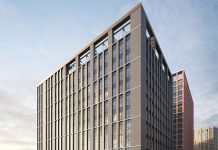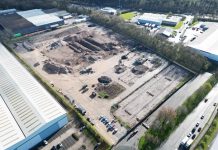The Central London office market showed its resilience in the final quarter of 2016 with both the occupational and investment markets showing improvements on Q3, according to commercial property specialist Avison Young.
It its Central London Office Briefing for Q4, the world’s fastest-growing commercial real estate services firm, reports that activity levels improved significantly on the previous quarter, but were some way behind the levels of 2015.
Nick Rock, of Avison Young’s Central London office team, said: “Last June’s vote to leave the EU had an impact across the whole market, with the London office market feeling the effects of economic uncertainty in Q3. However, in Q4 both the investment market and occupational markets recovered some ground.
“Take-up picked up significantly in Q4 with a total of 2.51m sq ft of new lettings reported, up 70% from Q3, taking the total for 2016 to 8.78 m sq ft. That said this was well below the total for 2015 which stood at 13.85 m sq ft.”
Against this, availability increased by over 15% in Q4 2016 to stand at 14.36 m sq ft compared with 11.06 m sq ft in Q4 2015. The 2016 figure was also well below the 5-year average of 17.4 m sq ft.
The vacancy rate across Central London increased to 6.1% – a rise of 130 basispoints over the year. Despite this, average rents continued to rise to £53.60 per sq ft, an increase of over 8% from 12 months ago. The upward trend meant that over the course of 2016, rents rose to a ten-year high in each of the major Central London sub-markets.
West End
Avison Young’s Q4 Market Briefing reveals that the West End was the only one of the key markets that experienced reduced volumes of leasing activity in the closing quarter of 2016, with take-up falling over 21% compared with Q3 with just over 442,000 sq ft of new lettings being reported (30% down on the level reached in Q4 2015).
Take-up for the West End as a whole stood at 2.16 m sq ft, a fall of over 37% from the figure for 2015.
The average office rent across the West End fell a fraction to £63.63 sq ft during Q4. However, rents in the Mayfair and St James’s submarkets continued to rise, with rents in St James’s overtaking Mayfair, with an average rent of £81.96 sq ft.
Nick Rock said: “The fact that average rents in St James’s are now higher than in Mayfair is a reflection of availability, the inward investment the area has experienced in recent times and the continued popularity of the area with corporate and financial occupiers.”
The pipeline of new developments in the West End market fell by 135,000 sq ft to stand at 1.7 m sq ft, with 87,000 sq ft being accounted for by a single property – GPE’s 30 Broadwick Street development in Soho.
Midtown
Leasing activity in the Midtown market was fairly subdued throughout 2016, but take-up rose 354,000 sq ft during Q4, an increase of 51% on the previous quarter. However, the annual total of 1.18 m sq ft was less than half of the total for 2015.
Average rents for the Midtown market reached £53.76 per sq ft, with the biggest increases witnessed in Covent Garden where, despite higher vacancy rates, average rents now exceed £65 per sq ft. The level of the development pipeline in Midtown has remained largely static at 2.06 m sq ft, compared with 2.07 m sq ft at the start of 2016.
City
In the Square Mile and City fringe markets, take-up rallied in Q4 with an increase in leasing activity to1.12 m sq ft , a 61% uplift compared to Q3 and 17% higher than the same period in 2015.
Nick Rock said: “While activity levels in the City market during the final quarter of 2016 were healthy, the figures for the full year were disappointing at just 3.23 m sq ft – well below the 2015 total of 5.75 m sq ft and the five-year average of 5.19 m sq ft.
“The supply of offices in the City increased to 8.86 m sq ft, almost double the amount available at the end of 2015 and above the five-year average. The level of supply is be expected to rise further with almost 2 m sq ft being added to the City’s development pipeline, which stood at 7.55 m sq ft at the end of Q4.
“At the same time, vacancy rates for offices in the City rose by over 300 basis points in the last quarter to 10%, reaching double digit levels for the first time since Q3 2014.”
The Avison Young report highlights that despite the increase in vacancy rates, average rents across the City continued to rise, reaching £52.93 sq ft with average rents in the City core reaching £55.00 per sq ft.
Central London – office investment
The office investment market in central London recovered from a poor third quarter with trading volumes in the City market during Q4 totaling £1.86bn, they were more than double those recorded in the previous quarter. In the Midtown market, transacted volumes tripled to stand at £308m in Q4, although these trading volumes are still substantially lower than the levels recorded in the same quarter of 2015.
The West End market was the worst performer of the central London office sub sectors in Q4, with trading volumes falling by 16% compared to the previous three months. This is 50% lower than the five-year average. The total volume for West End office transactions in Q4 stood at £383m, compared with the £1.5bn recorded in the same period of 2015.
Nick Rock said: “Our opinion is that the figures for the West End are not an indication of a negative shift in sentiment but more a reflection of the low availability of stock.”
Overseas investors accounted for 49% of transactions in the central London office market in Q4, a decrease of 71% on the previous quarter. The figure does suggest that the weakness of Stirling is still a strong incentive for international investors.
Nick Rock commented: “With the Pound remaining weak we expect that for the first half of 2017 at least, overseas buyers will continue to account for the lion’s share of investment volumes and that those investors who gambled by investing in the UK during a very uncertain period immediately post-referendum, could reap handsome rewards.”






















